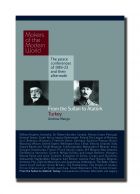Buy or gift a stand-alone digital subscription and get unlimited access to dozens of back issues for just £18.99 / $18.99 a year.
Please register at www.exacteditions.com/digital/cornucopia with your subscriber account number or contact subscriptions@cornucopia.net
Buy a digital subscription Go to the Digital EditionCyril Mango has long been an authority on Byzantium. Now Andrew Mango has published an important biography of Atatürk. Yet the brothers were brought up in Istanbul between the wars in a pool of European culture barely touched by Turkish politics. They told their story to David Barchard. Portrait by Charles Hopkinson
A year or two into the premiership of the late Turgut Özal, sometime in the middle of the 1980’s, the late Adnan Kahveci, then the prime minister’s chief adviser, asked me to give him a selection of books on the Byzantine Empire…
I gathered together about half a dozen leading works on the subject, flagged their best sections, and gave them to him. A week later he rang me.
“The best scholar on Byzantium is obviously Cyril Mango,” he said.
This autumn, scholars of modern Turkey have been feeling something rahter similar about Cyril’s brother Andrew. His biography of Atatürk has been greeted with more or less universal acclaim. It is likely to stand for many decades as a landmark in its field.
Norman Stone introduces a special report by rescuers and writers on the August earthquake and its aftermath
Yolande Whittall looks back at 1930s life in Moda, across the strait from the domes and minarets of Istanbul. In Grandmother Whittall’s garden, where the snow fell deep and crisp, tobogganing parties were laid on for the children. In the kitchen Christmas puddings were stirred, and shooting parties provided the wherewithall for woodcock pie…
War and Peace: Ottoman Relations in the 15th to 19th centuries’, an exhibition at the Museum of Turkish and Islamic Arts, Istanbul, 1999 For 500 years the Polish elite was obsessed with all things Ottoman. Yet a brilliant exhibition celebrating this passion went sadly unnoticed. Philip Mansel reports.
Nine thousand years ago, the plain of Konya was a hive of activity. Before the Mesopotamians, Minoans or Egyptians, the people of Çatalhüyük created one of the first cities known to man. James Mellaart, who unearthed the city and its stunning wall paintings, recalls the stages of a momentous discovery
Soon after blue and white ceramic was born in China, it made its first glorious appearance in a mosque in the early Ottoman capital of Edirne. John Carswell unlocks a well-kept secret
A 20-page celebration of Safranbolu, the perfect small town. The lovingly maintained Mümtazlar Konağı is just one of the many handsome old houses that distinguish the Anatolian market town of Safranbolu. With iron deposits, lush forests and fields growing the valuable saffron croci that gave the town its name, Safranbolu prospered quietly for 1,500 years.
This modest plant grows easily, cooks easily and digests easily. It is also an excellent health giver. The 10th century physician Ibn-Sina (Avicenna) recommends leeks against colds, coughs and unclean air.
More cookery features






Cornucopia works in partnership with the digital publishing platform Exact Editions to offer individual and institutional subscribers unlimited access to a searchable archive of fascinating back issues and every newly published issue. The digital edition of Cornucopia is available cross-platform on web, iOS and Android and offers a comprehensive search function, allowing the title’s cultural content to be delved into at the touch of a button.
Digital Subscription: £18.99 / $18.99 (1 year)
Subscribe now